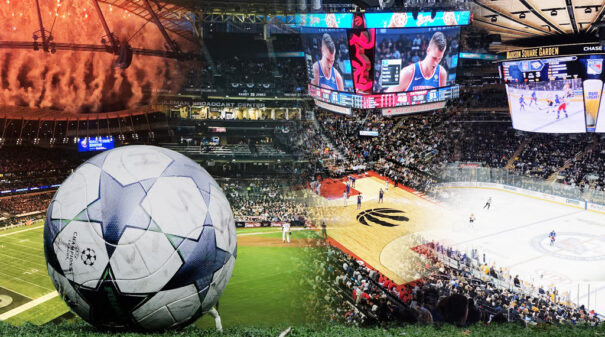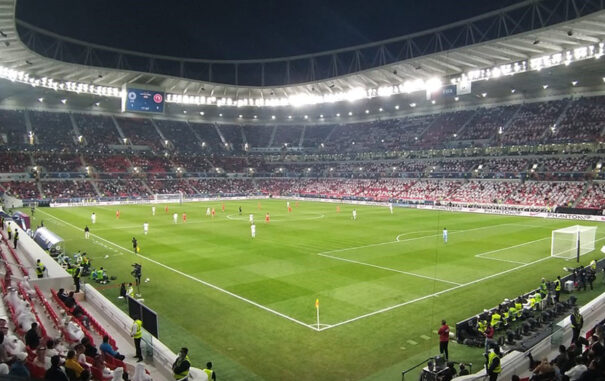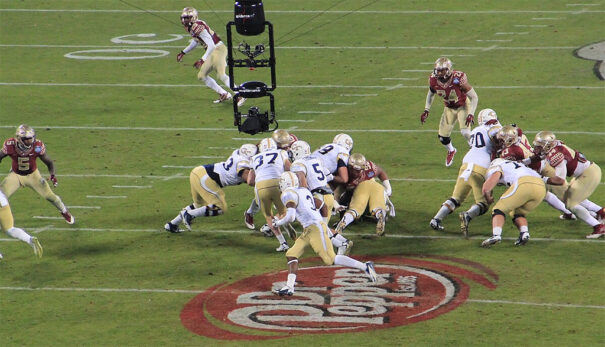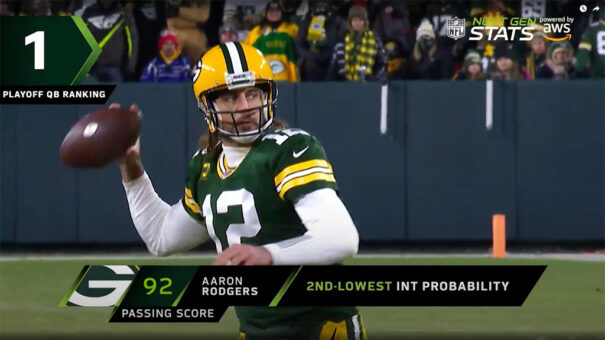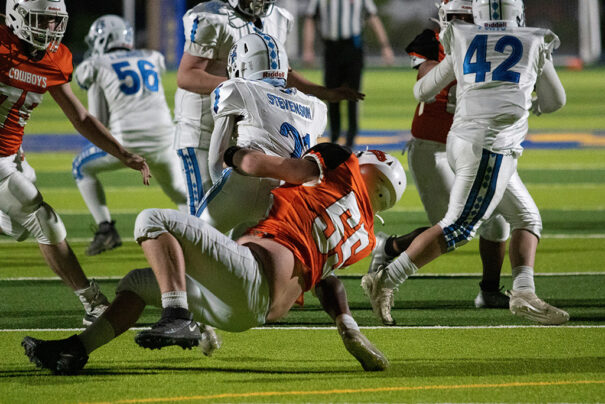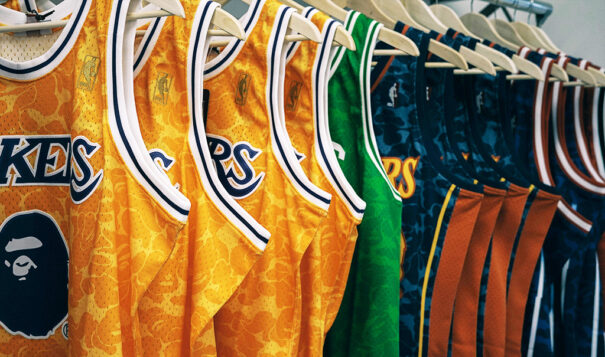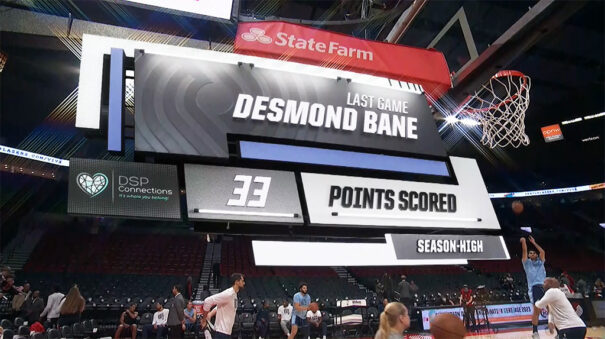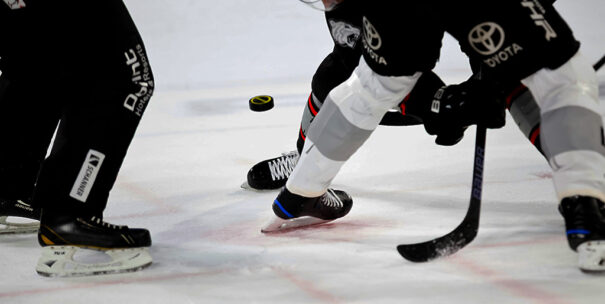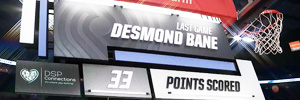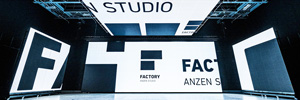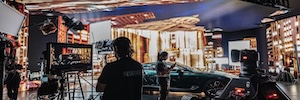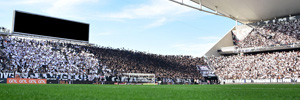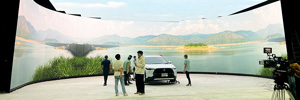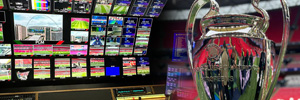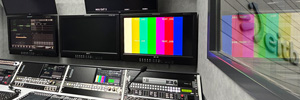9 innovaciones broadcast de la NFL, MLB, NBA y NHL… ¿con futuro en el fútbol?
El Top 4 de las principales competiciones deportivas de EE. UU., la NFL (Fútbol americano), MLB (Béisbol), NBA (Baloncesto) y NHL (Hockey sobre hielo) siguen innovando año tras año para implementar nuevos recursos audiovisuales que ayudan a crear retransmisiones tan espectaculares como explicativas. Si bien cada deporte tiene sus particularidades, existen técnicas que, con el enfoque correcto, podrían permeabilizar en el deporte rey de Iberoamérica: el fútbol.
En un tiempo en el que el entretenimiento audiovisual transforma sus formatos, duraciones y puestas en escena hegemónicos, el deporte sigue intrínsicamente legados a sus pilares fundacionales. El fútbol es un ejemplo de esta situación. Directamente, sus 90 minutos de duración, con su respectivo intermedio y tiempos de descuento, contradice a los principales manuales de estilo de la generación Z.
Ante las sugerencias de una parte de la industria de modificar las reglas del deporte para hacerlo más atractivo para las nuevas industrias, la iniciativa privada se ha encontrado con una disyuntiva. Por un lado, algunos agentes han apostado por jugar al máximo con las reglas del juego para transformarlo en el show visual que tantos solicitaban y construir la Kings League con sus derivados: una competición futbolística con un alcance reducido, pero con una notable inversión en tecnología broadcast que aúna fútbol y espectáculo, como trasladaron a Panorama Audiovisual Álex Miñana (realizador) y Raúl Alarcón (director técnico de Highvideo).
La otra alternativa es la que están apostando las principales competiciones futbolísticas: jugar con los límites de las retransmisiones en pro del engagement y la inmersividad. El UHD con elementos de NGA ya es aplicada por la británica BT Sport para la Premier League, apostando por la fidelidad de imagen, mientras que la Serie A adopta un modelo de producción remota desde hace varias temporadas. Entre tanto, LaLiga, a través de Mediapro, apuesta por múltiples alternativas de realización que toman en gran medida influencia de los videojuegos (con las cámaras cinematográficas con steady sobre el terreno o los tiros de cámara en jugadas a balón parado) y mira a los ojos a las nuevas generaciones, que tienen a los streamers como ídolos poniendo el foco en el narrador en el momento en el que cantan un gol. Estas son unas pocas de las decenas de otras iniciativas de realidad aumentada, estadísticas, cámaras de cable o drones empleadas por la compañía catalana.
Innovación en el fútbol
Ante una FIFA inamovible en lo que respecta a las reglas del fútbol en el futuro cercano, el camino de la innovación audiovisual seguirá siendo un importante valor para las federaciones para garantizar el seguimiento de las audiencias, lo que debería garantizar los millonarios contratos que mueven el deporte rey en toda Europa. Los equipos de I+D y los think tanks relacionados con el mundo deportivo trabajan incansablemente para buscar nuevas soluciones tecnológicas que aporten más posibilidades a las producciones. Otros buscarán el valor fuera de nuestras fronteras, ya sea gracias a foros internacionales, reuniones bilaterales, open days de competiciones que comparten sus últimos progresos tecnológicos o a la democratización que ofrece el acceso a Internet para poder apreciar los pasos que han tomado otros compañeros de profesión.
La NFL (Fútbol americano), MLB (Béisbol), NBA (Baloncesto) y NHL (Hockey sobre hielo) son cuatro de las mayores referencias mundiales en lo que respecta a las retransmisiones deportivas de deportes de equipo (excluyendo, en el proceso, a los deportes de motor). Cada año, invierten millones de euros en crear producciones broadcast de primer nivel. Si bien en ocasiones estas ligas se han inspirado en formatos y tecnologías en algunos de los procesos implementados en el fútbol del viejo continente, todas ellas también se encuentran aplicando interesantes enfoques que, con el tratamiento adecuado, podrán pasar a formar parte de las retransmisiones futbolísticas.
1. Usos alternativos de cable-cam (NFL)
La NFL, la principal liga de lo que se conoce en Europa como fútbol americano, se suele atribuir el mérito de usar el primer cable-cam en una retransmisión deportiva. La efeméride nos lleva 40 años atrás, cuando una versión limitada del sistema captó un encuentro de pretemporada entre los San Diego Chargers y los San Francisco 49ers. El sistema se abandonaría a favor de otros recursos para hacer su regreso triunfal en la Super Bowl LI (2017) con una gran recepción del público, especialmente por el carácter táctico de las tomas.
El mundo del fútbol ha innovado en el uso de las cable-cam desde hace más de una década, ofreciendo un acercamiento sin precedentes a las jugadas. En este sentido, la NFL no descubre ninguna tecnología nueva, pero sí exploraciones alternativas a estas herramientas desde un prisma imaginativo. Una de las aplicaciones más frecuentes ha sido el despliegue de dos sistemas cable-cam en el mismo estadio, tal y como se usó en la Super Bowl LVII (2023). Concretamente, se montaron una cámara 4K y una cámara super slow-motion que servirían para tomas en directo, repeticiones y aplicaciones de realidad aumentada. Ambas cámaras conviven siendo situadas a diferentes alturas, ofreciendo una un análisis más táctico de la disposición de los jugadores; un uso que Mark Lazarus, responsable de la división de Broadcasting & Sports de NBC, atribuyó a la “influencia de videojuegos como Madden” en 2018 en el portal oficial de la NFL. La cablecam principal, por su parte, se encuentra más cercana al terreno de juego para seguir de cerca a cada atleta.
Otras aplicaciones alternativas utilizadas en citas como la Super Bowl LIV (2020) fue el despliegue de cable-cam para realizar tomas desde el exterior hacia el interior del estadio a través de la estructura de edificio, ofreciendo un nuevo contexto de los encuentros en situaciones en los que los sistemas de drones puedan estar limitados.
2. Seguimiento individualizado de jugadores (NFL)
La tiranía del dato se ha convertido en una variable imprescindible para la planificación estratégica de los entradores, que ante unas sensaciones condicionadas permite un análisis detallado del rendimiento de los jugadores. Existen decenas de herramientas especializadas, ya sean propietarias de las propias ligas de fútbol o de sistemas de terceros, como la italiana Wyscout, que se beneficia de la recolección de datos para otorgar datos concretos sobre cada uno de los jugadores, o la herramienta Mediacoach.
La NFL comenzó un recorrido en 2013 con el testeo de estas herramientas de GPS, infrarrojos, etiquetas RFID y soluciones basadas en radiofrecuencia para poder recopilar información detallada, entregando en tiempo real esos datos bajo el nombre Next Gen Stats (NGS) a los broadcasters en 2015 y ampliando sus posibilidades en 2020 con tecnología de machine-learning en 2020. De esta forma, de recopilar parámetros individualizados de distancia recorrida o velocidad máxima, se pasó a incluir probabilidades de éxito o la predicción de yardas recorridas.
La imprescindible importancia táctica del fútbol americano, así como el refinamiento del sistema NGS, ha provocado que la versión más reciente de este sistema, que se beneficia de las etiquetas RFID and photo sensors (en España estos datos son captados a través de 16 cámaras de tracking óptico y tres cámaras tácticas), sean utilizados en profundidad en las retransmisiones dado que los datos son proporcionados en tiempo real con diferentes opciones de representación a las televisiones. Según Keegan Abdoo, parte del equipo de NGS, Prime Video incluye en sus retransmisiones el 95% de los datos que son entregados en tiempo real a través de un canal exclusivo para ver cada encuentro con los datos ofrecidos en tiempo real.
Al margen de estas aplicaciones, que han podido ser exploradas en mayor o menor medida dentro del fútbol, la NFL ha favorecido el uso de las segundas pantallas (al estilo de las retransmisiones de carreras motor) a través de NGS Live. Este sistema, accesible en abierto a través de su portal web, proporciona a los seguidores del deporte la posibilidad de tener estadísticas detalladas e individualizadas en tiempo real del partido, incluyendo claves como el movimiento y seguimiento de cada uno de los jugadores en tiempo real.
3. Tecnologías de slow motion vía software (NFL)
Las cámaras de slow motion and ultra slow motion son una constante consolidada en el mundo del fútbol. En LaLiga, son utilizadas desde hace más de una década, teniendo su máximo protagonismo en encuentros de alta relevancia como los Real Madrid vs. Barcelona. En El Clásico del 20 de marzo de 2022, de hecho, Mediapro decidió desplegar un total de 10 cámaras superlentas: 4 high speed y 6 super slow motion.
La NFL sigue apostando por el uso de este tipo de cámaras en los estadios, pero la mejora de los sensores de las cámaras, el uso de resoluciones en UHD con cámaras hasta 8K y el progreso en el procesamiento vía software de las señales producidas están empujando a la competición a un modelo de captación en la que cualquier cámara puede convertirse en una slow motion. Concretamente, la NFL se beneficia de la tecnología Xtramotion de EVS, basada en servicios de procesamiento basados en cloud y algoritmos evolucionados con inteligencia artificial. No obstante, la NFL usó para la Super Bowl LVII (2023) un sistema piloto alojado en las instalaciones del estadio para reducir los tiempos de procesamiento y escalar los 60 fps y 180 fps de sus cámaras a 180 fps y 540 fps, respectivamente.
El sistema, que abre la puerta a una importante versatilidad y que presumiblemente será aplicado de forma similar cada vez con más compañías, ya ha dado sus primeros pasos en el mundo del fútbol, con su inclusión en la fan cam de partidos de Champions League ofrecidos por NVP para Sky Italia.
4. Drones customizados dentro del estadio (MLB)
Al igual que la NFL cuenta con la Super Bowl, partido que regala año tras año innovaciones de alcance mundial, la liga número uno dedicada al béisbol en Estados Unidos cuenta con sus propios encuentros especiales en los que se presenta en sociedad el esfuerzo de sus equipos de ingeniería y realización. En el último partido MLB All-Star Game, celebrado el 11 de julio en el T-Mobile Park de Seattle, se logró un acuerdo para incluir por primera vez el uso de los drones dentro de los estadios durante el desarrollo del juego. Eso sí, para garantizar la seguridad de los aficionados, estos sistemas personalizados que montan una cámara con un estabilizador gimbal solo se utilizan en momentos en los que no haya riesgo de ser golpeado por una de las bolas: en las presentaciones de los jugadores o en los diferentes innings del partido.
En España, existe una importante legislación con respecto al uso de drones, tal y como recogió este artículo ofrecido por Bardaji & Honrado en Panorama Audiovisual. No obstante, sería fácil imaginar el uso de estos dispositivos en la introducción de los jugadores, en los momentos de tensión durante la revisión de una jugada en el VAR o en el momento de los cambios bajo la pericia de un operador profesional.
5. Dirtcam: a ras de suelo (MLB)
En el fútbol, el terreno de juego es sagrado. Salvo con la incursión de cámaras a pie de campo en celebración de goles o al término de los partidos, la FIFA se muestra completamente reacia a incluir cámaras que, de alguna forma, puedan interferir en el desarrollo de la acción bajo argumentos como la protección de la integridad de los jugadores. Mención aparte es la odisea de aprobación de nuevas soluciones, que suele estar acompañada de extensos trámites y largos procesos de testeo.
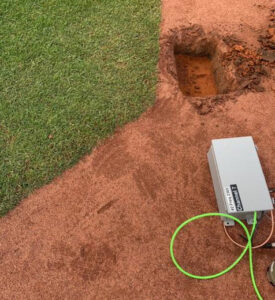 La MLB utiliza desde 2015 regularme las llamadas Dirtcam, una cámara microscópica wireless basada en RF que sobresale tan solo 4 milímetros y que se sitúa en diversas ubicaciones del terreno de juego. De este sistema excavado bajo tierra emerge un minúsculo prisma, que cuenta con protección a agua, golpes y pisadas, cuenta con control pan-tilt y permite ofrecer una vista privilegiada de algunos de los momentos más espectaculares de la acción.
La MLB utiliza desde 2015 regularme las llamadas Dirtcam, una cámara microscópica wireless basada en RF que sobresale tan solo 4 milímetros y que se sitúa en diversas ubicaciones del terreno de juego. De este sistema excavado bajo tierra emerge un minúsculo prisma, que cuenta con protección a agua, golpes y pisadas, cuenta con control pan-tilt y permite ofrecer una vista privilegiada de algunos de los momentos más espectaculares de la acción.
A falta de estudiar una posible ubicación dada la longitud del césped en los estadios (20-30 mm), la posibilidad de ver el golpeo de un balón a ras de suelo u observar cómo una pelota roza el poste en un gol podría aportar una inmersividad sin precedentes en el terreno de juego.
6. Sensores en las equipaciones deportivas (NBA)
La biometría, ya proceda de sistemas de captación internos o externos, supone un importante añadido que proporciona contexto sobre algunos de los sucesos más determinantes de los encuentros deportivos. Ya se han testado en pruebas olímpicas, eventos en los que las cámaras han logrado captar la pulsación de los distintos deportistas en momentos clave, algo que podría ser aplicado del mismo modo entre el lanzador y el portero en el momento del penalti decisivo de la tanda.
Al margen de estos recursos (recordamos que las principales ligas deportivas cuentan con sus principales sistemas de estadísticas proporcionadas por sistemas de captación), existe un importante interés en seguir captando datos con diferentes métodos. Entre ellos, procede el último acuerdo de la NBA firmado con la empresa canadiense Plantiga, una compañía que integra sistemas de sensores en las zapatillas de los jugadores para comprender claves como los mecanismos de lesión, demandas de rendimiento, cargas y asimetrías de los atletas. En el caso del fútbol, la capacidad de captar parámetros como velocidad, cadencia, contacto con el suelo, aceleración, duración de la carrera o la altura de los santos ofrecería nuevos parámetros que integrar en las retransmisiones especialmente en disputas defensivas con pico de velocidad o en los saltos a la hora de rematar un balón en los córneres.
Otra empresa que alcanzó un acuerdo con la NBA fue Nextiles, la cual une tejidos con semiconductores para que estos promocionen métricas como tiempo en el aire, impulso del salto, simetría entre piernas (especialmente importante para la prevención de lesiones) y fuerzas aplicadas en diferentes momentos del juego. La Liga de Fútbol Portuguesa ya lleva trabajando varios años en este sentido, incluyendo sensores en las diferentes prendas de sus futbolistas.
7. AR aplicada a cámaras de mano / hombro (NBA)
La realidad aumentada se ha convertido en una constante en las retransmisiones deportivas, ya sea proporcionando datos asociados a una jugada (como el posicionamiento de los jugadores sobre el terreno de juego), o beneficiándose del procesamiento de imágenes y la realidad mixta para sustituir los anuncios que rodean el terreno de juego por publicidad personalizada por mercados.
No tan frecuente es la aplicación de realidad aumentada no-falseada sobre el terreno de juego utilizando cámaras handhell, un proceso para el cual los Trail Blazers ha creado un flujo de trabajo personalizado basándose en tecnología de Disguise and Stype. El equipo de producción del equipo instaló un hardware de seguimiento en el estadio que utilizó el sistema de seguimiento RedSpy con una cámara de infrarrojos que apuntaba a los marcadores en el techo del pabellón. A continuación, se instaló un servidor multimedia que habilitó el uso de gráficos de realidad aumentada en tiempo real con integración de datos.
A falta de techos en la gran mayoría de estadios de fútbol, y sin la posibilidad de aplicar estas referencias en el terreno de juego, la instalación de beacons dispuestas en puntos claves del entorno del estadio, similar a las propuestas de los entornos museísticos y retail, podría ser una propuesta para integración de este tipo de alternativas, si bien la industria precisa de soluciones mucho más certeras para añadir este tipo de elementos que ayudarían a seguir profundizando en la inmersividad en las retransmisiones deportivas.
8. Sensores integrados en los balones de fútbol (NHL)
El balón de la Copa del Mundo de la FIFA de Catar 2022 incluía en su interior un pequeño sensor creado por Kinexon. Integrado en el corazón de cada balón y con un peso de tan solo 14 gramos, este sistema incluía un sensor de ultrabanda ancha (UWB) para posicionar en tiempo real la ubicación del esférico, y un sensor de medida inercial (IMU) para detectar el movimientos sutiles del objeto en el espacio. A través de estas soluciones, enviadas en tiempo real, procesadas con IA y coordinadas con las soluciones de tracking de Hawk-Eye, se trabajo en en el “fuera de juego semiautomático”, nuevo sistema que previsiblemente en las próximas temporadas pasará a ser un estándar de la FIFA.
La recolección de datos a través del balón de juego es solo la punta de iceberg para un sinfín de estadísticas que pueden ser extraídas en tiempo real a través de estos sensores. La NHL, la competición predilecta de hockey sobre hielo de Estados Unidos, lleva varios años de ventaja a la FIFA y la gran mayoría de ligas de fútbol profesional, pues desde 2021, cada uno de los discos se dedica a proporcionar datos. La gran diferencia es que esta sensorización no proviene del interior de la pelota, sino de una serie de sensores dispuestos en la superficie del disco and trackeada por entre 16 y 28 cámaras.
Este sistema de captación, entrenado y evolucionado jornada a jornada con soluciones basada en IA y el procesamiento de AWS, acabó por conformar la propuesta NHL Edge, un sistema que ofrece métricas como calidad del disparo, calidad de la parada, distancia recorrida, mapas de calor de disparos o la velocidad. La combinación de los sistemas de sensores incluidos en el interior del balón, junto con la disposición de sensores externos al balón, podría ofrecer una miríada de alternativas para seguir profundizando en el mundo de las estadísticas y su inclusión en las retransmisiones.
9. Creación de realidades alternativas (NHL)
A comienzos de 2023, la NHL, ESPN and Disney Channel se aliaron para transformar el encuentro entre los New York Rangers y los Washington Capitals en un encuentro animado con los personajes favoritos de la serie de animación Big City Greens. Utilizando los datos de trackeo NHL Edge, que recogen datos de cada jugador (hasta 29 puntos diferentes en el jugador y 5 en el stick) y del disco, el equipo de producción del encuentro pudo superponer una capa para transformar los jugadores en avatares virtuales. Adicionalmente, dos de los actores de doblaje de la serie hicieron un trabajo en tiempo real con captura facial para aportar un mayor realismo a las reacciones de cada uno de los protagonistas.
Esta iniciativa, según declaró para SVG Michael “Spike” Szykowny, director senior de motion graphics y planificación de la producción de ESPN Creative Studio, buscó expandir la audiencia de la competición para acercar a los más jóvenes de la casa al mundo de la NHL. Incluso permitió expandir las posibilidades de la realización: al llevar los datos paramétricos a un entorno virtual, el equipo de la productora pudo incluir hasta 49 ángulos de cámara virtual.
Los datos paramétricos de los futbolistas requerirían de muchos más puntos de referencia, así como se precisaría de una solución para hacer realista el desplazamiento de los jugadores por el campo frente al deslizamiento del hockey. Sin embargo, sería una original alternativa para, al menos una vez al año, acercar al deporte a nuevas audiencias con personajes animados o a través de representaciones cartoon de cada uno de los jugadores.
Un reportaje de Sergio Julián Gómez
Did you like this article?
Subscribe to us RSS feed And you will not miss anything.



